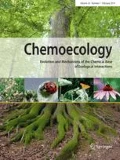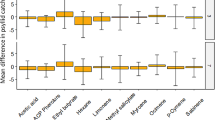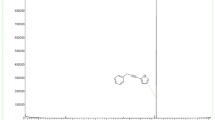Abstract
The importance of long-chain alkanes and free fatty acids present in leaf surface waxes of two Commelinaceae rice-field weeds, Commelina benghalensis L. and Murdannia nudiflora (L.) Brenan, was evaluated as short-range attractant and oviposition stimulant in the Lema praeusta (Fab.) (Coleoptera: Chrysomelidae). Surface waxes were extracted by dipping leaves in n-hexane for 1 min at 27 ± 1 °C. Thin-layer chromatography, gas chromatography–mass spectrometry, and gas chromatography–flame ionization detection analyses of n-hexane extracts revealed 20 n-alkanes from C14 to C36 and 13 free fatty acids from C12:0 to C22:0. Pentacosane and palmitoleic acid were predominant among n-alkanes and free fatty acids, respectively. Females showed attraction to one leaf equivalent surface wax of both weeds against the control solvent (petroleum ether) in Y-tube olfactometer bioassays. However, the insect could not discriminate between one leaf equivalent surface waxes of two weeds, suggesting that both weeds were equally attractive to females. Among all identified alkanes and fatty acids, females showed attraction towards individual docosane, tricosane, pentacosane and heptacosane, and tridecanoic acid, palmitoleic acid, linoleic acid, and arachidic acid, resembling in amounts as present in one leaf equivalent surface wax of C. benghalensis and M. nudiflora, respectively. A synthetic blend of either docosane, tricosane, pentacosane, and heptacosane, resembling in amounts as present in one leaf equivalent surface wax of C. benghalensis, or tridecanoic acid, palmitoleic acid, linoleic acid, and arachidic acid, resembling in amounts as present in one leaf equivalent surface wax of M. nudiflora, served as short-range attractant and oviposition stimulant in L. praeusta.





Similar content being viewed by others
References
Adhikary P, Mukherjee A, Barik A (2014) Role of surface wax alkanes from Lathyrus sativus L. seeds for attraction of Callosobruchus maculatus (F.) (Coleoptera: Bruchidae). J Stored Prod Res 59:113–119
Adhikary P, Mukherjee A, Barik A (2015) Attraction of Callosobruchus maculatus (F.) (Coleoptera: Bruchidae) to four varieties of Lathyrus sativus L. seed volatiles. Bull Entomol Res 105:187–201
Adhikary P, Mukherjee A, Barik A (2016) Free fatty acids from Lathyrus sativus seed coats acting as short-range attractants to Callosobruchus maculatus (F.) (Coleoptera: Bruchidae). J Stored Prod Res 67:56–62
Ahmed S, Opena JL, Chauhan BS (2015) Seed germination ecology of doveweed (Murdannia nudiflora) and its implication for management in dry-seeded rice. Weed Sci 63:491–501
Barik A, Bhattacharya B, Laskar S, Banerjee TC (2004) The determination of n-alkanes in the cuticular wax of leaves of Ludwgia adscendens L. Phytochem Anal 15:109–111
Caton BP, Mortimer M, Hill JE, Johnson DE (2010) A practical field guide to weeds of rice in Asia. International Rice Research Institute, Philippines
Das S, Koner A, Barik A (2018) Biology and life history of Lema praeusta (Fab.) (Coleoptera: Chrysomelidae), a biocontrol agent of two Commelinaceae weeds, Commelina benghalensis and Murdannia nudiflora. Bull Entomol Res. https://doi.org/10.1017/S0007485318000731
Dodoš T, Rajčević N, Tešević V, Matevski V, Janaćković P, Marin PD (2015) Composition of leaf n-alkanes in three Satureja montana L. subspecies from the Balkan peninsula: ecological and taxonomic aspects. Chem Biodivers 12:157–169
Eigenbrode SD, Espelie KE (1995) Effects of plant epicuticular lipids on insect herbivores. Annu Rev Entomol 40:171–194
Grant GG, Zhao B, Langevin D (2000) Oviposition response of spruce budworm (Lepidoptera: Tortricidae) to aliphatic carboxylic acids. Environ Entomol 29:164–170
Harborne JB (1994) Introduction to ecological biochemistry. Academic Press, London
Holm LG, Plucknett DL, Pancho JV, Herberger JP (1977) The world’s worst weeds: distribution and biology. University Press of Hawaii, Honolulu
Isaac W-A, Gao Z, Li M (2013) Managing Commelina species: prospects and limitations. In: Price AJ, Kelton JA (eds) Herbicides-current research and case studies in use. Intech, Croatia, pp 543–562
Jetter R, Schaffer S, Riederer M (2000) Leaf cuticular waxes are arranged in chemically and mechanically distinct layers: evidence from Prunus laurocerasus L. Plant Cell Environ 23:619–628
Karmakar A, Malik U, Barik A (2016) Effects of leaf epicuticular wax compounds from Solena amplexicaulis (Lam.) Gandhi on olfactory responses of a generalist insect herbivore. Allelopathy J 37:253–272
Karmakar A, Mitra S, Barik A (2018) Systemically released volatiles from Solena amplexicaulis plant leaves with color cues influencing attraction of a generalist insect herbivore. Int J Pest Manag 64:210–220
Koukos D, Meletiou-Christou M-S, Rhizopoulou S (2015) Leaf surface wettability and fatty acid composition of Arbutus unedo and Arbutus andrachne grown under ambient conditions in a natural macchia. Acta Bot Gallica 162:225–232
Li G, Ishikawa Y (2006) Leaf epicuticular wax chemicals of the Japanese knotweed Fallopia japonica as oviposition stimulants for Ostrinia latipennis. J Chem Ecol 32:595–604
Malik U, Barik A (2015) Free fatty acids from the weed, Polygonum orientale leaves for attraction of the potential biocontrol agent, Galerucella placida (Coleoptera: Chrysomelidae). Biocontrol Sci Technol 25:593–607
Malik U, Barik A (2016) Volatiles and surface wax long-chain alkanes and free fatty acids from Polygonum orientale L. (Polygonaceae) flowers. Bot Lett 163:453–460
Malik U, Mitra S, Barik A (2017) Attraction of the biocontrol agent, Galerucella placida Baly (Coleoptera: Chrysomelidae) to the leaf surface alkanes of the weed, Polygonum orientale L. Allelopathy J 40:103–116
Manosalva L, Pardo F, Perich F, Mutis A, Parra L, Ortega F, Isaacs R, Quiroz A (2011) Behavioral responses of clover root borer to long-chain fatty acids from young red clover (Trifolium pratense) roots. Environ Entomol 40:399–404
Mitra S, Sarkar N, Barik A (2017) Long-chain alkanes and fatty acids from Ludwigia octovalvis weed leaf surface waxes as short-range attractant and ovipositional stimulant to Altica cyanea (Weber) (Coleoptera: Chrysomelidae). Bull Entomol Res 107:391–400
Mukherjee A, Barik A (2016) Long-chain primary alcohols in Momordica cochinchinensis Spreng leaf surface waxes. Bot Lett 163:61–66
Mukherjee A, Sarkar N, Barik A (2013) Alkanes in flower surface waxes of Momordica cochinchinensis influence attraction to Aulacophora foveicollis Lucas (Coleoptera: Chrysomelidae). Neotrop Entomol 42:366–371
Mukherjee A, Sarkar N, Barik A (2014) Long-chain free fatty acids from Momordica cochinchinensis leaves as attractants to its insect pest, Aulacophora foveicollis Lucas (Coleoptera: Chrysomelidae). J Asia Pac Entomol 17:229–234
Mukherjee A, Sarkar N, Barik A (2015) Momordica cochinchinensis (Cucurbitaceae) leaf volatiles: semiochemicals for host location by the insect pest, Aulacophora foveicollis (Coleoptera: Chrysomelidae). Chemoecology 25:93–104
Müller C (2006) Plant–insect interactions on cuticular surfaces. In: Riederer M, Muller C (eds) Biology of the plant cuticle. Blackwell Publishing, Oxford, pp 398–422
Müller C, Hilker M (2001) Host finding and oviposition behavior in a chrysomelid specialist—the importance of host plant surface waxes. J Chem Ecol 27:985–994
Padovan A, Keszei A, Köllner TG, Degenhardt J, Foley WJ (2010) The molecular basis of host plant selection in Melaleuca quinquenervia by a successful biological control agent. Phytochemistry 71:1237–1244
Parr MJ, Tran BMD, Simmonds MSJ, Kite GC, Credland PF (1998) Influence of some fatty acids on oviposition by the bruchid beetle, Callosobruchus maculatus. J Chem Ecol 24:1577–1593
Piasentier E, Bovolenta S, Malossini F (2000) The n-alkane concentrations in buds and leaves of browsed broadleaf trees. J Agric Sci 135:311–320
Piesik D, Wenda-Piesik A, Ligor M, Buszewski B, Delaney KJ (2012) Dock leaf beetle, Gastrophysa viridula Deg., herbivory on the mossy sorrel, Rumex confertus Willd: induced plant volatiles and beetle orientation responses. J Agric Sci 4:97–103
Sarkar N, Barik A (2014) Alkanes from bitter gourd as allelochemicals in olfactory responses of Epilachna dodecastigma (Wied.). Allelopathy J 33:43–51
Sarkar N, Barik A (2015) Free fatty acids from Momordica charantia L. flower surface waxes influencing attraction of Epilachna dodecastigma (Wied.) (Coleoptera: Coccinellidae). Int J Pest Manag 61:47–53
Sarkar N, Mukherjee A, Barik A (2013) Long-chain alkanes: allelochemicals for host location by the insect pest, Epilachna dodecastigma (Coleoptera: Coccinellidae). Appl Entomol Zool 48:171–179
Sarkar N, Malik U, Barik A (2014) n-Alkanes in epicuticular waxes of Vigna unguiculata (L.) Walp. leaves. Acta Bot Gallica 161:373–377
Sarkar N, Mukherjee A, Barik A (2015) Attraction of Epilachna dodecastigma (Coleoptera: Coccinellidae) to Momordica charantia (Cucurbitaceae) leaf volatiles. Can Entomol 147:169–180
Sarkar N, Mitra S, Barik A (2017) Momordica charantia L. (Cucurbitaceae) floral volatiles causing attraction of Epilachna dodecastigma (Coleoptera: Coccinellidae). Int J Pest Manag 63:138–145
Schoonhoven LM, van Loon JJA, Dicke M (2005) Insect-plant biology. Oxford University Press, Oxford
Smith L, Beck JJ (2013) Effect of mechanical damage on emission of volatile organic compounds from plant leaves and implications for evaluation of host plant specificity of prospective biological control agents of weeds. Biocontrol Sci Technol 23:880–907
Udayagiri S, Mason CE (1997) Epicuticular wax chemicals in Zea mays influence oviposition in Ostrinia nubilalis. J Chem Ecol 23:1675–1687
van Maarseveen C, Jetter R (2009) Composition of the epicuticular and intracuticular wax layers on Kalanchoe daigremontiana (Hamet et Perr. de la Bathie) leaves. Phytochemistry 70:899–906
Wheeler GS, Schaffner U (2013) Improved understanding of weed biological control safety and impact with chemical ecology: a review. Invasive Plant Sci Manag 6:16–29
Wilson AK (1981) Commelinaceae—a review of the distribution, biology and control of the important weeds belonging to this family. Trop Pest Manag 27:405–418
Acknowledgements
We thank anonymous reviewers for many helpful suggestions of earlier versions of the manuscript. We are thankful to Dr. Janakiraman Poorani, Principal Scientist, National Research Centre for Banana, Tamilnadu for identifying the insect, and Prof. Ambarish Mukherjee, Department of Botany, of this University for identification of these weeds. The financial assistance from the University of Burdwan as a JRF to Swati Das is gratefully acknowledged. We also thank DST PURSE Phase-II for providing necessary instrumental facilities.
Author information
Authors and Affiliations
Corresponding author
Additional information
Communicated by Marko Rohlfs.
Electronic supplementary material
Below is the link to the electronic supplementary material.
Rights and permissions
About this article
Cite this article
Das, S., Koner, A. & Barik, A. A beetle biocontrol agent of rice-field weeds recognizes its host plants by surface wax long-chain alkanes and free fatty acids. Chemoecology 29, 155–170 (2019). https://doi.org/10.1007/s00049-019-00285-1
Received:
Accepted:
Published:
Issue Date:
DOI: https://doi.org/10.1007/s00049-019-00285-1




